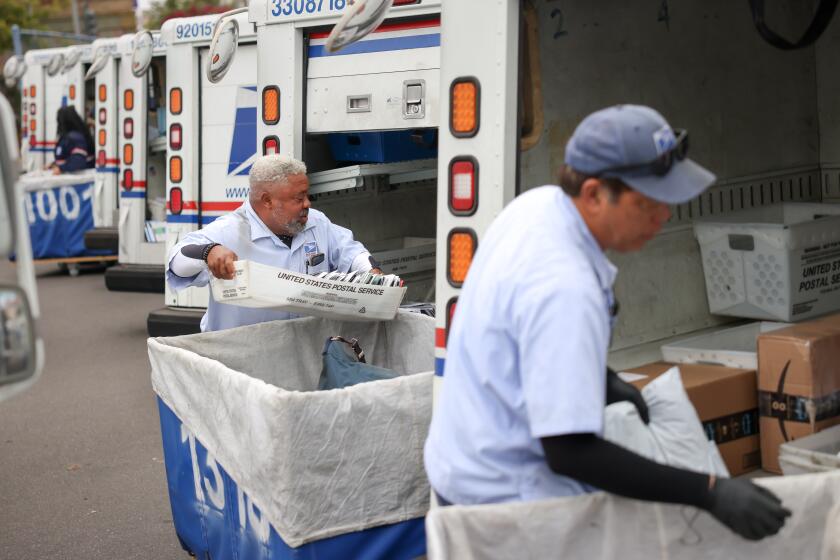Gold Glitters in Exposition Park Exhibit
- Share via
When King Croesus of Lydia ordered the first gold coin struck in Asia Minor in 560 BC, he not only created a medium of exchange, but launched man’s eternal search to acquire the precious metal.
Today the Natural History Museum of Los Angeles County opens an exhibit, “Gold: The Quest for New World Riches,” which curators are billing as one of the most comprehensive displays ever assembled in the United States. The collection ranges from pre-Columbian gold objects to high-tech space-age applications of the yellow metal; from intricate gold masks and necklaces fashioned by Peruvian Indian craftsmen to pieces of mining machinery used in the California mother lode.
Gold does not rust, tarnish or corrode and is impervious to time. Little wonder that lust for the metal has resulted in some of the most violent chapters in the history of the Americas. That the search for gold brought waves of settlers to the Americas, beginning with the Conquest of Mexico, is one of the underlying themes of the museum’s exhibit.
Thousands Massacred
By the time Spanish explorer Hernando Cortes and his conquistadores had completed their conquest of Mexico in 1521, thousands of Indians had been massacred and about 13 tons of golden artifacts melted down--because ingots and coins were easier to divide and transport. The loss of these treasures of Aztec and Mayan culture is recorded in one of the exhibits. But the coins salvaged from sunken Spanish ships--once destined to fill the coffers of the Spanish Crown--are still lustrous.
Also on view are examples of leaf and wire gold, and the largest existing gold nugget from California, which weighs 156 ounces. The showcasing of the nugget is an example of the artistry with which the entire exhibition is displayed. In a single case, spotlighted by tiny pinpoints of light, it seems to float in the darkened room. Also displayed are 200 pounds of nuggets, more than half from Sierra County, where gold is still being found. One showcase contains the golden spike used to join the east and west sections of the first transcontinental railroad at Promontory Point, Utah, on May 10, 1869. There is a watch chain of interwoven gold strands that a group of California businessmen presented to President Lincoln during the Civil War. One wonders what became of the watch.
For Californians, one of the most interesting items may be the small nugget, discovered by James Marshall, that became the catalyst for one of the greatest gold rushes in history.
Gold in 1848
Jan. 24, 1848, was a cold wintry day at Coloma on California’s American River when James Marshall made his startling discovery. He had been sent there to build a sawmill by Sacramento Valley cattle baron John Sutter. Many years later, Marshall accompanied a correspondent for Century magazine to the site, recounting what had taken place that day:
“As I was taking my usual walk along the race after shutting off the water, my eye was caught with the glimpse of something shining in the bottom of the ditch . . . I reached my hand down and picked it up; it made my heart thump, for I was certain that it was gold. The piece was about half the size and of the shape of a pea. Then I saw another piece in the water. . . .”
Marshall brought the nuggets to his employer, who tried to keep news of the find secret. This failed, and thousands flocked to California in search of wealth. They butchered Sutter’s cattle, overran his lands and stole his property. Bankrupt, Sutter was stripped of his holdings. Marshall ended his days embittered and working as a gardener.
Corporate support for producing the exhibit was provided by the American Express Travel Related Services Co. Inc., the Precious Metals Investment Group, a division of Security Pacific National Bank, the Homestake Mining Co. and Monex International.
Tickets for the exhibit, which will run through May 17, are available from Ticketmaster (located in the May Co., Sportmart and Music Plus stores) or at the museum. They are priced at $4 for adults and $2 for students and seniors (62 and older). Children under 12 are free with a paying adult.
Tickets must be purchased for specific dates and times. However, once inside the gold exhibit, you can stay as long as you wish. You can also visit all the other exhibits in the museum. There are a number of lectures and films related to gold being held on weekends through May. For information, phone (213) 744-DINO. There are no tickets available for today.
The Natural History Museum is located at 900 Exposition Blvd. in Exposition Park, one block east of Vermont Avenue. Parking is available adjacent to the museum for $1 ($5 during Coliseum events). There’s a cafeteria on the ground floor.
More to Read
Sign up for Essential California
The most important California stories and recommendations in your inbox every morning.
You may occasionally receive promotional content from the Los Angeles Times.










